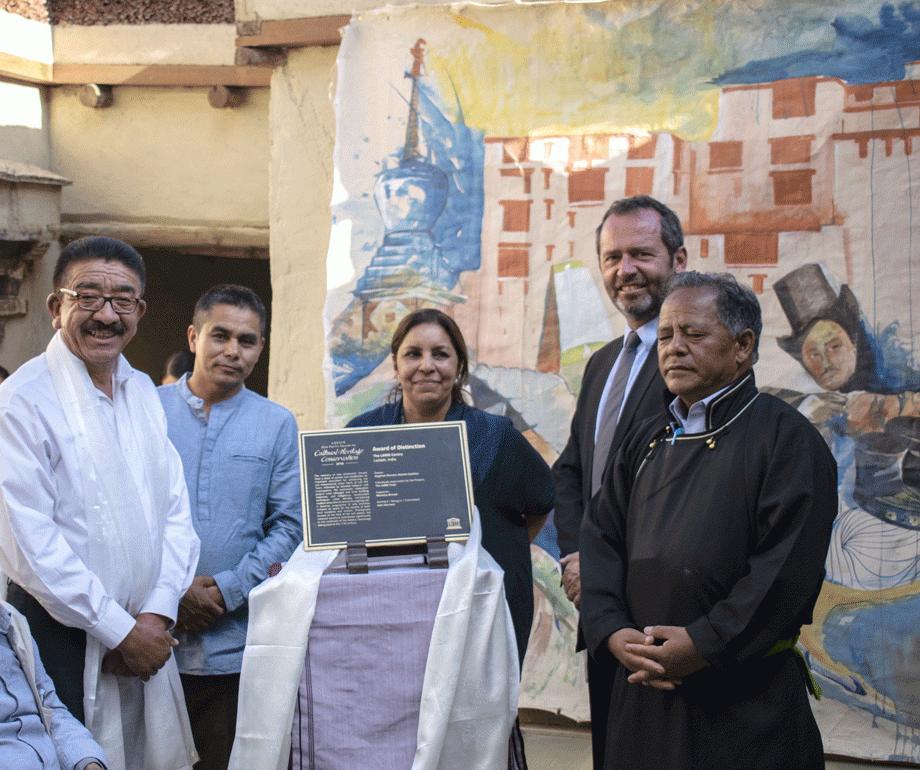LAMO Centre gets UNESCO Asia-Pacific Award

Commemorating the occasion of winning the Award of Distinction by UNESCO Asia-Pacific Awards for Cultural Heritage Conservation in November 2018, Ladakh Arts and Media Organization (LAMO) invited Eric Falt, Director, UNESCO, New Delhi, to Leh for the celebration.
A panel discussion on ‘Built Heritage in Ladakh’, followed by the unveiling of the award plaque by the owners of the two houses, Dr. Angchuk of Munshi House and Stanzin Gyaltson of Gyaoo House along with Dr. Monisha Ahmed, Executive Director and Co-Founder, LAMO and Tashi Morup, Project Director, LAMO. Music performance with contemporary Ladakhi musicians and vocalist was also showcased on July 8.
Eric Falt, Director and UNESCO Representative for the UNESCO New Delhi Cluster Office, informed the audience that apart from built heritage, UNESCO is now looking at the Intangible Cultural Heritage (ICH) which is one of the Sustainable Development Goals of the United Nations. He expressed the tremendous potential for Ladakh to come up with projects, with a common unified agenda and vision with community participation.
Dr. Monisha Ahmed spoke on the restoration of the Munshi and Gyaoo houses that make up the LAMO Centre, and the potential of rejuvenating and adapting historical buildings so that they can be used as contemporary spaces. She said that culture is not merely rooted in tradition but is also open to change and innovation. Though change is inevitable, it is also important to acknowledge and understand the past.
Dr. Angchuk Munshi, owner of the Munshi House shared the history about his house in the context of the Old Town of Leh, including the dates preceding the 17th Century and the construction of the Namgyal Palace. He elaborated the historical information through written documents maintained by his great grandfather, Munshi Spalgyas, as well as the Moravian Missionary August Hermann Francke and a 15th-century thangka depicting his family members led by Guru Chospel (forefather) that he possesses.
Wangyal Tsering, Convenor of INTACH Ladakh Chapter, raised conservation challenges faced in Ladakh in light of the modern developments taking place. Also, he highlighted the initiatives being taken by INTACH towards conservation and the formulation of regulation and legislation for heritage sites.
A structural engineer by profession, Wangyal Tsering has taken part in many conservation projects in various monasteries in Ladakh. Also, he designed some large-scale statues of Buddha at Likir, Diskit, Nye and Stok.
Phunchok Stobdan, Former Indian Ambassador to Kyrgystan and the Founding President of Ladakh International Centre, Leh stressed on the importance of nature in the conservation of heritage. He also spoke about the lack of representation in Ladakh to speak for the conservation of historic buildings that are a vital part of the region’s heritage.
Noorjahan Chunka, who works as a freelance Art Conservator, raised an important issue regarding opportunities for the younger generation to explore in the field of Conservation and the potential for work in Ladakh. She also identified the challenges and problems faced in the region.
Questions over the issues and opportunities in the conservation field in Ladakh were raised including challenges of conserving the heritage because of modern infrastructural developments, future of conservation of Ladakh, private ownership of the monuments, heritage regulations and youth’s role and responsibilities.
The panel discussion reached a consensus over the importance of community participation in protecting and conserving, the rich and wide range of heritage, both tangible and intangible, prevailing across the Trans-Himalayan Ladakh. Also, exploring the possibility of nominating the Old Town of Leh as a UNESCO World Heritage Site.





